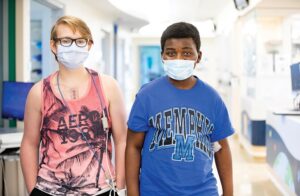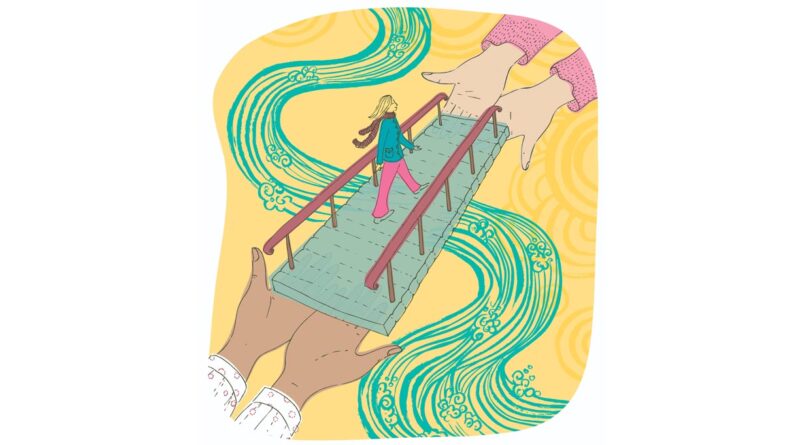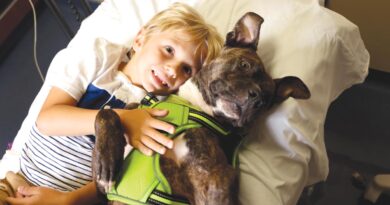Bridges of Support
Published on November 11th, 2022 by Christina Echegaray.
Rob Fulford and Tracey Hicks — one from West Tennessee and the other from East Tennessee — probably wouldn’t have ever met except for happenstance.
Both extremely sick and in heart failure at the same time, they bonded over the need for a single device that saved their lives and served as a bridge to receive heart transplants, and perhaps as a bridge to a lifelong friendship.
Rob, 15, and Tracey, 16, were the first two pediatric patients, respectively, at Monroe Carell Jr. Children’s Hospital at Vanderbilt to receive an Impella 5.5 left ventricular assist device (VAD) — each receiving their device exactly one week apart in August.
The Impella 5.5 is an implantable mechanical device that supports the left ventricle of the heart and helps circulate blood throughout the body. It is designed to supplement the pumping function of a patient’s heart when it’s too weak to pump blood adequately on its own and to serve as bridge to heart transplantation.

An added benefit of the Impella, which can be used for up to 14 days, is that it does not require open-heart surgery. Instead, the device is inserted by catheter percutaneously, or through the skin, entering through the axillary artery (the main artery of the upper limb), to the aorta.
“The other VADs all require open-heart surgery with a sternotomy. With this device we are able to put it in with just a small graft to the axillary artery, so the incision is much smaller. This is much less invasive in how it’s placed while still providing the full VAD support to the heart,” said David Bearl, MD, MA, a pediatric cardiologist at Monroe Carell and medical director of the Pediatric Ventricular Assist Device Program. “With both of these young men, we were able to get them extubated fairly quickly and up and moving around in 24 hours.”
Growing the VAD program
Monroe Carell has used ventricular assist devices for about 17 years. As the VAD program has grown and evolved, the team’s toolbox to provide the best heart support possible has also grown. Along with Bearl, the VAD Program is supported by Nancy Jaworski, APRN, DNP, VAD Program coordinator, and Nhue Do, MD, surgical director of the program and a pediatric heart surgeon.
The team works to evaluate patients sooner since evidence shows that VADs help improve the health of patients as a bridge to transplant. When the heart doesn’t have to work as hard, other body systems have time to recuperate, which can help improve post-transplant recovery.
Since the hospital’s first pediatric ventricular assist device surgery was performed in 2005, VADs have been implanted in 52 children at Monroe Carell, with 19 of those implanted since 2020.
“As our program has matured, we’ve been able to think about what next technologies we might be able to bring to the hospital, especially in the setting of how it provides a unique care opportunity for the patient,” Bearl said. “We’re doing six to eight devices a year now, whereas it was two to three before we established the program, and every single one of those patients has made it to transplant. It is a testament not just to our work, but to the entire Pediatric Heart Institute and the support work of that team.”

In the 25 years since the first pediatric heart transplant was performed at Vanderbilt, the program has become one of the highest-volume, most experienced pediatric heart transplant programs in the nation. The team follows about 150 transplant patients with continuing care at any given time. More of these patients are evaluated for VAD support as a bridge to transplant.
Currently, the VAD program employs four different VADs — Berlin Heart, PediMag/CentriMag, HeartMate 3, and most recently, the Impella.
Monroe Carell is among about 25 heart centers in the United States using the Impella in adolescents and adults with congenital heart disease. Use of the device in pediatrics is more recent. Vanderbilt University Medical Center has used the Impella in adults since 2008.
Nearly 170 people across the Pediatric Heart Institute at Monroe Carell were trained in preparation for the first implantation of the Impella. They are trained for the Impella 5.5 and CP models, which are indicated for adolescents and larger children because the patient’s axillary artery must be 7 millimeters or greater.
‘The VAD saved my life’
On Aug. 8, Rob became the first pediatric patient at Monroe Carell to receive the latest VAD. He was in heart failure, a consequence of the long-term effects of chemotherapy and radiation treatments when he was 3 years old.
The Memphis teen, who loves to play harmonica and video games, was diagnosed at age 2 with a
Wilms tumor, a rare kidney cancer that primarily affects child-ren. He lost his left kidney and had aggressive treatments.
Just before his 14th birthday, he became sick and fatigued, and was diagnosed with heart failure, becoming increasingly ill over the next year. On July 29, he was admitted to Monroe Carell with fluid building in his lungs and around his heart.
“The VAD saved my life,” Rob said. “It is a blessing. To have the machine is a lifesaver.”
“The Impella is designed to protect his organs,” said Rob’s mom, Teresa Howard. “It protected his lungs — they were bad when he came here.”
A week after Rob had his Impella implanted, Tracey got his device on Aug. 15.
Having already been through the procedure, Rob would walk by Tracey’s room. “I am an inspirational person, so I would say to him, ‘Stay strong my brother. You got this.’”
“When you’re feeling down and you only have your parents, having a friend in the hospital who can relate, he knows how you feel too,” Rob said.
Tracey’s health decline was sudden and unexpected. What his parents believed was a cold turned out to be more serious. He went to an urgent care clinic near their home in East Tennessee. When an antibiotic for an ear infection didn’t work, they took Tracey to the ER, where he was diagnosed with pneumonia and sent to Niswonger Children’s Hospital in Johnson City. A matter of hours later, he was on a mechanical ventilator for breathing support and was transferred to Monroe Carell on July 25.
“It turned out he has a genetic mutation of the RBM20 gene that caused the dilated cardiomyopathy,” said Tracey’s mom, Kimberly Courtner. “This was something we never knew he had until he got so sick.”
Dilated cardiomyopathy is a type of heart muscle disease that causes the heart ventricles to thin and stretch, making it harder for the heart to pump effectively. Medicines didn’t work to mitigate Tracey’s heart failure. His lungs continued to fill with fluid. That’s when the team decided to put him on the VAD.
“The Impella allowed him to live and breathe well while waiting on the heart transplant without being on the ventilator. He was able to talk and get up with the Impella as well,” Courtner said.
“(The VAD) was literally the only thing keeping me alive. The left side of my heart had basically stopped working,” Tracey said.
With the VAD, the teens walked the hallways together for physical therapy to keep them strong until transplant. They played online video games against one another from their own rooms.
Allowing a child or teen to develop as normally as possible while waiting for heart transplantation is also extremely important, notes Jaworski.
“We want children to be able to wait in as healthy of a state as possible for their transplant in as normal a childhood kind of situation as possible. We want them awake; we want them eating; we want them playing; we want them moving; we want them breathing on their own,” Jaworski said.
Ready, set, ACTION
Monroe Carell Jr. Children’s Hospital at Vanderbilt is a member of the Advanced Cardiac Therapies Improving Outcomes Network (ACTION). Read more »
Rob received his heart transplant on Aug. 17, with Tracey receiving his four days later on Aug. 21.
Jaworski said Rob and Tracey exemplify the team’s goals for pediatric patients on VADs.
“Because both of these kids came in at the same time, they have become buddies. It’s awesome. Pre-transplant they actually had gotten together to play cards a couple times, and as they recovered, each one of them made a point each day to walk by the other one’s room to cheer him on or tell the other ‘good job,’” Jaworski said.
Courtner said Rob was a motivator for Tracey.
“It helped encourage Tracey to know that he had a newfound friend going through the same things that he was going through. It also encouraged him to get up and go out to check on Rob to ensure he was doing well too,” she said.
Both Rob and Tracey are on the road to recovery, and they have seen each other during follow-up visits in the clinic.
Rob has a positive outlook and pulls inspiration from quotes, including one that means a lot to him and his situation.
Quoting in part an unknown author, Rob said, “Never regret a day in your life. Good days give you happiness, and bad days give you experience.”




